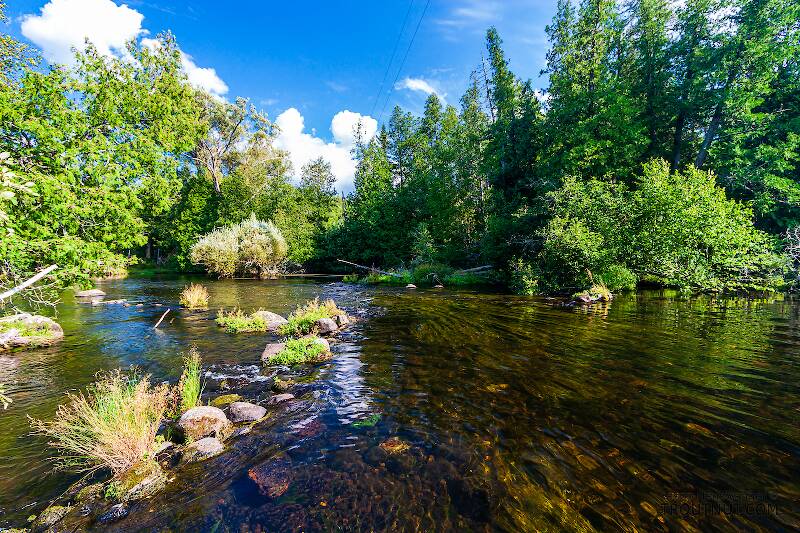
Blue-winged Olives
Baetis
Tiny Baetis mayflies are perhaps the most commonly encountered and imitated by anglers on all American trout streams due to their great abundance, widespread distribution, and trout-friendly emergence habits.


Stonefly Species Megaleuctra complicata (Tiny Winter Blacks)
Species Range
Identification
Species ID from GBIFthe Global Biodiversity Information Facility
Source: The Genus Megaleuctra Neave (Plecoptera: Leuctridae) In North America
Diagnosis. The combination of paired, conical, widely-separated lobes, on tergum 9 and the absence of a basal forked structure (Figs. 2 - 3, 6), the distinctive apex of the subanal probe (Figs. 3, 5, 10, 14, 16), and large angular epiproct (Figs. 3, 5, 7, 13, 15, 17) separate the male of Megaleuctra complicata from all other western North American species. The radial sector of the female forewing usually has three branches which may, with caution, be used to distinguish it from females of other western North American Megaleuctra.
Physical description
Most physical descriptions on Troutnut are direct or slightly edited quotes from the original scientific sources describing or updating the species, although there may be errors in copying them to this website. Such descriptions aren't always definitive, because species often turn out to be more variable than the original describers observed. In some cases, only a single specimen was described! However, they are useful starting points.
Description from GBIFthe Global Biodiversity Information Facility
Source: The Genus Megaleuctra Neave (Plecoptera: Leuctridae) In North America
Male. Macropterous, but some populations in northern California exhibit brachyptery (Fig. 85). Length of forewing 12 - 13 mm; body length 11 - 12 mm. General color brown. Wings hyaline, with dark pigment occupying about half the costal space beyond the cord. Radial sector of forewing with three branches. Tergum 8 sometimes with a pair of small lobes (Fig. 3). Tergum 9 with a pair of widely separated conical lobes, without a basal forked structure (Figs. 2 - 3, 6, 13, 15); subgenital plate tongue-like, apex rounded (Fig. 18); epiproct variable in shape, depending on expansion position. In midlength position, the upper portion is narrower at the base and expanded near the apex in dorsal view and is subparallel tapering along the middorsal groove (Fig. 13), the anterior portion is expanded into blunt lateral processes, bearing a loose fringe of small stout spines, the lower portion is broader at the base, the apex wedge-shaped laterally and directed downward as two large stout hooks, extending beyond the apex of the upper process (Figs 13, 15, 17). In expanded position, the upper portion is broader at the base and narrow at the apex, fitting into grooves on each side of the expanded lower process (Figs. 2, 5 - 8), the large wedge-shaped hooks of the lower process are visable on each side of the apex (Fig. 8, 9), the expanded epiproct has a dorsal groove that can cover the apex of the subanal probe (Fig. 6). Subanal probe can be free from the epiproct (Figs. 3, 5) or it can fit into the middorsal groove of the epiproct (Figs. 5 - 6), tip greatly expanded in lateral view, exhibiting a deep notch, between the narrow elongate upper lobe and a broadly rounded lower lobe, which bears a distinct tube (Figs. 3, 10, 14, 16, 17); cerci consisting of an elongate single segment (Figs. 3, 5, 18); Vesicle long and thin and covered with sparse long hairs (Fig. 11).
Female. Macropterous, but some populations in northern California are slightly brachypterous. Length of forewing 14 - 15 mm; body length 13 - 14 mm. Coloration similar to male. Radial sector of forewing with three branches. Sternum 8 with subgenital plate extending past tip of abdomen 1.5 - 2.0 mm (Figs. 19, 20), narrowed gradually to tip, round in cross section (Fig. 4). Sternum 9 formed into a long, narrow ovipositor; cerci inconspicuous (Figs. 4, 20).
Larva. Described by Stewart & Sandberg (2004).
Start a Discussion of Megaleuctra complicata
References
- Jacobus, L. M., Wiersema, N.A., and Webb, J.M. 2014. Identification of Far Northern and Western North American Mayfly Larvae (Insecta: Ephemeroptera), North of Mexico; Version 2. Joint Aquatic Science meeting, Portland, OR. Unpublished workshop manual. 1-176.
Stonefly Species Megaleuctra complicata (Tiny Winter Blacks)
Species Range
Common Names
Resources
- NatureServe
- Integrated Taxonomic Information System
- Global Biodiversity Information Facility
- Described by Claassen, P.W. (1937) New species of stoneflies (Plecoptera). Journal Kansas Entomological Society 10, 42–51.

